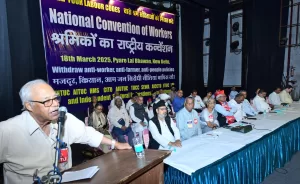Like many English speaking people around my age, the first time I remember hearing about the women’s suffrage movement was in the books and film featuring the character Mary Poppins. It was the banker’s wife, Mrs. Banks, who was a fervent supporter of the suffragette struggle fr the right to vote. Mary Poppins, an imaginative nanny whose job was to take care of the children in financially well-off families, seemed amused at the concept. It’s not that she was necessarily opposed, but that her struggles were more fundamental—income, shelter and food, for example. I never examined the books closely enough as an adult to decide what the politics of the author P.J. Travers were, but the books themselves remain a cleverly composed commentary on the British class system during the Empire’s height.
Anyhow, the nature of the suffragist’s movement and its relationship to the labor struggles of working class women in the United States during the years between 1880 and 1917 are but one of the questions addressed in the timely reprint of Meredith Tax’s outstanding history, The Rising of Women: Feminist Solidarity and Class Conflict, 1880-1917. The edition referred to in this piece was published by Verso in 2022. It is a reprint of the Monthly Review edition first published in 1980. The Verso edition includes a 2021 foreword by journalist Sarah Jaffe and a new introduction by the author also written in 2021. Both writers express their concern about the current crisis—economic, climate, post-pandemic—and the need not only for a renewed left and labor movement, but also for an autonomous women’s movement that is anti-capitalist, pro-labor and consequently beyond the so-called feminism of the Democratic party, its ancillaries and that of the university. Jaffe writes that Tax’s text clarifies that it is laboring women who are the key to radical change and cross-class alliances based on female concerns are useful but not necessary. Indeed, the nature of such alliances is dependent on the nature of the situation.
The historical narrative in The Rising of the Women begins with Part Two, titled “Chicago Will Be Ours.” In this section Tax provides an introduction to the period following the Civil War in the United States. She describes a rapidly industrializing nation, a major influx of immigrants, mostly from Europe. She also discusses the growing wealth of US capitalists and a growing economic inequality. At the same time, the text introduces the beginnings of a labor movement and a growing socialist consciousness Women’s role in these phenomena was complex and multilayered. Many women and girls found themselves seeking work. Even though men’s wages were low and their working conditions as exploitative as their wages, women’s wages were even lower and their conditions often worse. In addition, women were restricted in terms of their social lives because of the gender-based restrictions then in place. Indeed, women were not only considered less capable than men, they were often considered less than men, especially white men. This was reflected in the aforementioned wages, but also in the fact that the nascent labor unions did not allow them into their organizations. Of course, it’s a well-known fact that those unions usually did not allow Black men or men in certain immigrant groups.
This did not stop women from organizing. It did, however, create challenges to that organizing. The fact of capitalist exploitation of the working class was understood by most who labored. However, the question of how to minimize (or ideally, end) that exploitation was a question that provoked many arguments and disagreements. There were those who thought charity and mutual aid societies like Hull House to be the most effective. There were other women who believed enlisting government agencies and going the legislative route would work best. Then there were those who argued for unionism. Sometimes groups utilizing these various approaches worked in tandem and other times they didn’t. As Tax’s history explains, different approaches often found favor according to a women’s class background. Upper and middle class women who had a heart (and something of a social conscience) tended to donate to and work with the charities while also support legislation and the electoral route. On occasion—especially after a strike action was brutally attacked by police and other enforcers of capital—they added their voices, money and power to the working class girls and women in the factories and on the streets. Still, underlying their approach was a belief that capitalism could be progressive and could resolve the issues of exploitation and brutality it relied on for its profits.
Then there were the radicals. These were the women who, as Eugene Debs wrote, wished to rise with their class, not from it. In other words, they found the words and implications of their upper class and middle class sisters to be patronizing and even demeaning. It is these women, the organizations they formed and the battles they fought that make up the history in this book. Likewise, it is from their perspective that the author considers the strikes, meetings, walkouts and other actions taken by these revolutionary women in their struggle for justice. From well-known groups like the Industrial Workers of the World (IWW) to the lesser-known Women’s Trade Union League (WTUL) and from the storied garment workers’ strike against the garment industry to struggles against sweatshops in Chicago in the 1890s, Tax’s text keeps the reader glued to the tale being told. In what can best be described as seamless, her narrative weaves in the debates between suffragists and socialists, male-dominated and run labor unions and women workers, and pro and antiwar forces in the labor movement prior to the US entry into World War One. Similarly, she details the compromises and coalitions these various elements of the labor, women’s and leftist movements made in order to present a united front to those in power in Washington and the centers of finance.
At a time when movements for social justice have all too often become just another vehicle to irrelevance in the electoral realm and the Left is a divided shadow of what it was a couple decades ago, this reprinting of The Rising of the Women is both necessary and timely. In telling this story of the struggle for working women’s rights, the author reminds us of what is possible while also reminding us that seemingly insurmountable differences among those fighting for social justice should not be an excuse not to seek common ground and get on with the struggle.
(Ron Jacobs is the author of ‘Daydream Sunset: Sixties Counterculture in the Seventies’ published by CounterPunch Books. Courtesy: CounterPunch.)




